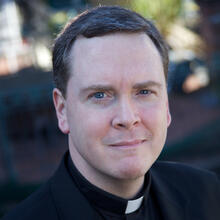Brother Joe Hoover, S.J., offers something in this issue that Jesuit brothers (but not always Jesuit fathers) are well-known for: truly helpful, practical information. He avoids the cliché “I hate to burst your bubble,” mainly because he so obviously doesn’t. Instead, he’s happy to tell us that the church is not in the midst of a civil war, unless you count the enervating toxicity that sometimes passes for discourse among the chattering elites on social media.
But the church is more than those folks, though it includes them; more than the bishops, theologians and the Catholic twitterazzi. A great deal more, in fact; on a magnitude of millions more. Not to beat a dead horse, but as I’ve often said in this column, the most important question we face today is not ethical, as our debate might suggest, but ecclesiological. Who do we mean when we say “the church”?
I ventured a response to that question in a recent column, which was well received, even if it was a tad esoteric. So I thought I’d try again, this time working from the bottom up, rather than the top down. Another reason it makes sense to talk about it this way is that in our hierarchical church, it is frequently, though not always or exclusively, the folks in the lower end of the hierarchy who appear closest to the Lord, as far as this can be discerned by outward appearances. (At the same time, it’s hard to fake holiness or joy, so outward appearances do count for something.)
The most important question we face today is not ethical, as our debate might suggest, but ecclesiological.
To wit: As I write this column, I am on a bus escorting 30 or so of your fellow America readers on a pilgrimage through northern Spain in the footsteps of St. Ignatius Loyola, the lead singer and driver of the Winnebago that was the 16th-century Society of Jesus. I love this annual trip. Ignatius is one of the great saints of all time and the experience of walking in his footsteps, in one of the most beautiful places on earth, never gets old.
But another part of what makes this place so special is the people you meet along the way, folks like the Franciscan brother who is the keeper of the keys at the ancient mountaintop shrine of Our Lady of Arantzazu in Guipuzcoa. Brother Antonio has the keys to the basilica. Well, he has one key, to be precise, for it opens every door.
Every day Brother Antonio leads pilgrims like us up 46 steps to a turnstile situated behind the main altar. Once there, he presses a button and the turnstile swivels and reveals the statue of our lady, about eight inches high, which mysteriously appeared amid the thorns on the mountainside some 500 years ago and has been an object of veneration ever since. St. Ignatius, Brother Antonio tells us, climbed this mountain and venerated Our Lady’s statue, choosing the occasion to renew his vow of chastity.
That’s impressive, but equally impressive is the figure of Brother Antonio himself. As the turnstile creaks round and exposes the statue, a broad smile comes to his face, as if he is seeing it for the first time. His eyes then quickly scan our faces, eager to see our reactions. All of this is really remarkable when one considers that Brother Antonio has been doing this same exact thing several times a day for 68 years. He arrived here at the age of 18 and has never left. Now, at the age of 86, he ascends the stairs at a slower clip, but with just as much pious humility and joy as if he were still a young man. When I asked yesterday what his favorite part of the statue was, he simply answered in Basque: “I could never choose. All of it is beautiful. She is beautiful. Like our mother, the church.”
What is the church? Wrong question. Who is the church? The right question.
Beautiful. Like Brother Antonio too. What is the church? Wrong question. Who is the church? The right question. And the answer is that the church is people like him, whose quiet faithfulness is, in fact, the silent though determined and constant shuffle of the church in her earthly pilgrimage.
Another way of putting this? When Jesus promised us that the gates of hell would not prevail against us, he wasn’t just saying that his life, death and resurrection were the guarantee of that promise (though they are). He was also saying that the gates of hell will not prevail because he would send us people like Brother Antonio, through whom, in a special way, the Lord is with us to the end of the age.
Thus, hope still lives. In the end, there is no civil war in the church because Jesus Christ has already won the only war worth fighting, the final battle between good and evil. That’s important to remember, especially now. And Brother Antonio, the keeper of the keys of our Lady of Arantzazu, is a testament to that joy-filled, hopeful, simple fact.









I LOVE THIS!!!! Mind=blown. Thank you, Fr. Malone!!!